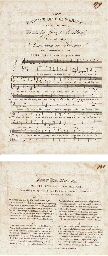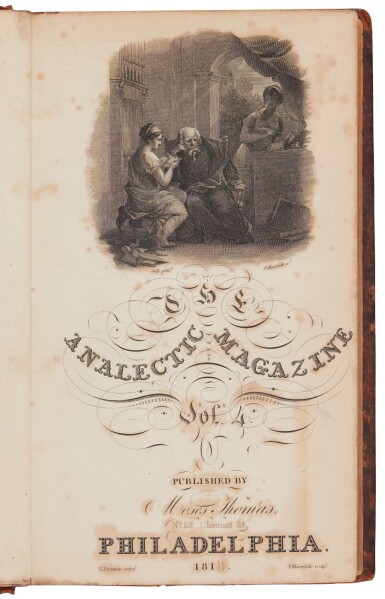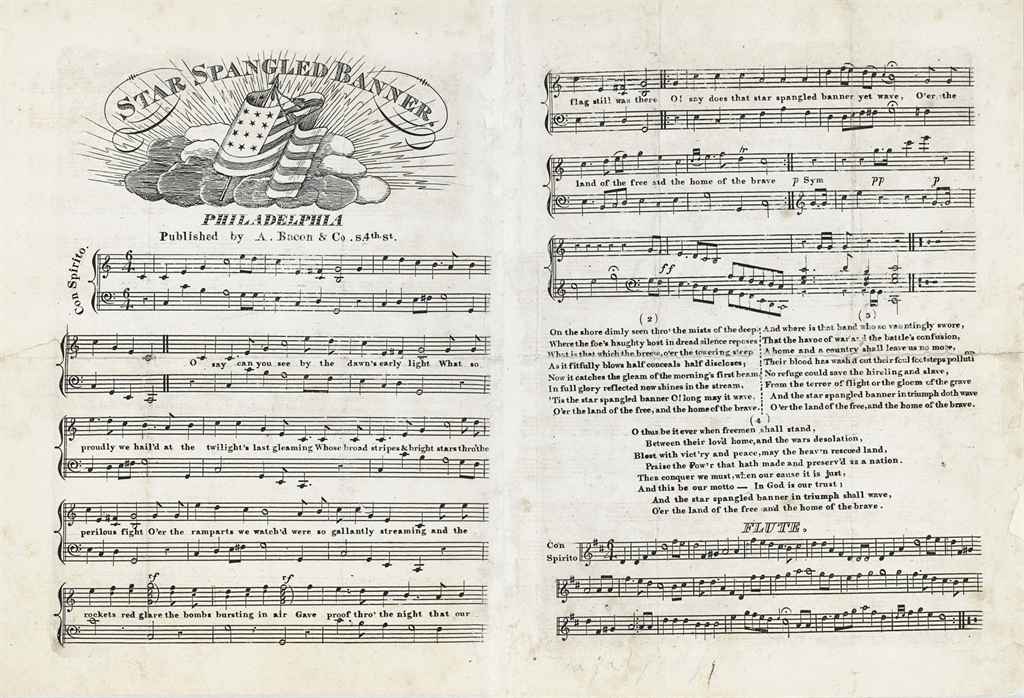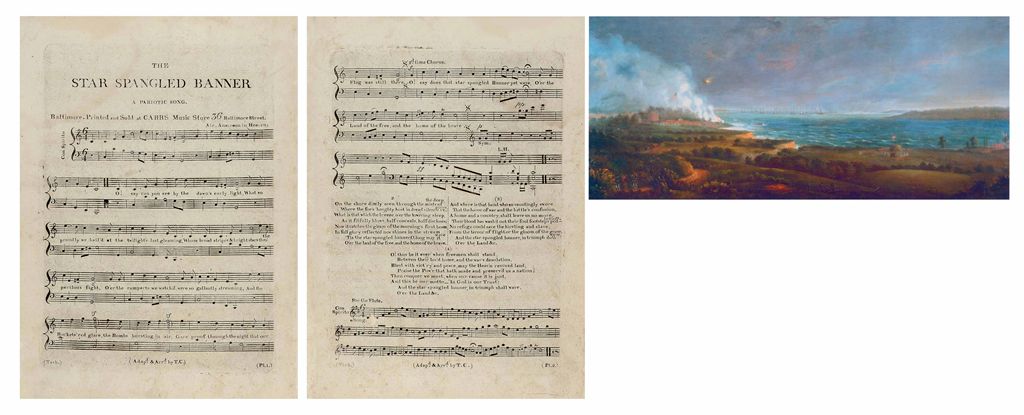STAR-SPANGLED BANNER, THE]. KEY, Francis Scott, poet. Fort Mc.Henry, or, The Star-Spangled Banner, Sung with great applause by Mr. Hardinge, at the Theatre Baltimore. Air, Anacreon in Heaven , printed on page 3 of HUTTON, Joseph. The Battle of the Wabash: A Patriotic Song...To the Favourite Air of Anacreon in Heaven . Philadelphia, published by G.E. Blake, n.d. [after 9 October 1814].
STAR-SPANGLED BANNER, THE]. KEY, Francis Scott, poet. Fort Mc.Henry, or, The Star-Spangled Banner, Sung with great applause by Mr. Hardinge, at the Theatre Baltimore. Air, Anacreon in Heaven , printed on page 3 of HUTTON, Joseph. The Battle of the Wabash: A Patriotic Song...To the Favourite Air of Anacreon in Heaven . Philadelphia, published by G.E. Blake, n.d. [after 9 October 1814]. Folio, 3 pages, 4to (12 7/8 x 9 in.). Engraved music and text from three plates. Page 1 with title in decorative calligraphy, music on two staves with text, additional stanzas of "The Battle of the Wabash," and "To Anacreon in Heaven" at bottom of page 2; page 3 with the decorative title "Fort Mc.Henry, or, The Star-Spangled Banner" and 4 full stanzas of Key's poem. Disbound (small binders' holes at gutter margin, light dampstain at top, lightly browned). THE RARE SECOND PRINTING OF THE WORDS AND MUSIC TO THE NATIONAL ANTHEM. This 1814 Philadelphia printing predates the amended first edition of the separate printing of the Star-spangled Banner, published in Baltimore in late 1814 or early 1815 (a copy of that issue was sold at Christie's, 9 December 1998, $22,000). Hutton's "The Battle of the Wabash" celebrated William Henry Harrison's victory over the Indians and British at the battle of Tippecanoe (7 November 1811) and was first published in 1812. The present is a reissue of that song, adding an extra page with the full text of Key's immensely popular anthem, which was performed, as the subtitle notes, "to great applause" in the Baltimore Theater as early as October 1814. The sequence of the various newspaper, broadside and sheet music appearances of "The Star-Spangled Banner" is quite complex, reflecting the song's rapid dissemination. In describing this edition, the Lilly Library exhibition notes that "The generally accepted second edition is "The Battle of the Wabash" [published in Philadelphia by G.E. Blake in an undated edition but unquestionably sometime in 1814]. The words of "To Anacreon in Heaven" are also reprinted and on the final sheet "Fort McHenry, or, The Star-Spangled Banner." Muller comments that this is the only appearance of the words of Anacreon and the Star-Spangled Banner together. "As all early editions of the song are undated, it is possible only to ascribe approximate dates to any given issue, based largely on the publisher's addresses, newspaper advertisements, etc." Francis Scott Key's stirring verses were inspired by a shipboard vigil on the night of September 13-14, 1814, while a British naval flotilla bombarded Fort McHenry. Key, a Baltimore lawyer, boarded a British vessel to secure the release of a friend held prisoner. During the bombardment, Key was detained. He spent the night on deck, watching shells rain onto the fort. From the outset the very large stars-and-stripes flag flying from the fort was clearly visible, but when the bombardment ceased, the flag was could not be seen. Key was distraught, thinking the Fort had been captured, but at dawn, when the flag was again visible, Key's emotions were powerfully stirred. His first draft of the anthem, entitled "Defence of Fort M'Henry," was allegedly written on an envelope, to be sung to the tune of the popular "Anacreontic Song," or "To Anacreon in Heaven," by the British composer John Stafford Smith. Upon Key's return to Baltimore, the song circulated as a handbill, appeared in a Baltimore newspaper (on 20 September) and was performed by Hardinge's theatrical company. A few months later the song was issued under the familiar title The Star-Spangled Banner . In 1931 the rousing song was formally recognized as the national anthem. Lilly Library, American Patriotic Songs, Indianapolis, 1968; J. Muller, The Star Spangled Banner, pp.52-57; J.Fuld, Book of World-Famous Music , p.532; Dichter and Shapiro, p.36; P.W.Filby and E.G. Howard, Star-Spangled Books , S8.
STAR-SPANGLED BANNER, THE]. KEY, Francis Scott, poet. Fort Mc.Henry, or, The Star-Spangled Banner, Sung with great applause by Mr. Hardinge, at the Theatre Baltimore. Air, Anacreon in Heaven , printed on page 3 of HUTTON, Joseph. The Battle of the Wabash: A Patriotic Song...To the Favourite Air of Anacreon in Heaven . Philadelphia, published by G.E. Blake, n.d. [after 9 October 1814].
STAR-SPANGLED BANNER, THE]. KEY, Francis Scott, poet. Fort Mc.Henry, or, The Star-Spangled Banner, Sung with great applause by Mr. Hardinge, at the Theatre Baltimore. Air, Anacreon in Heaven , printed on page 3 of HUTTON, Joseph. The Battle of the Wabash: A Patriotic Song...To the Favourite Air of Anacreon in Heaven . Philadelphia, published by G.E. Blake, n.d. [after 9 October 1814]. Folio, 3 pages, 4to (12 7/8 x 9 in.). Engraved music and text from three plates. Page 1 with title in decorative calligraphy, music on two staves with text, additional stanzas of "The Battle of the Wabash," and "To Anacreon in Heaven" at bottom of page 2; page 3 with the decorative title "Fort Mc.Henry, or, The Star-Spangled Banner" and 4 full stanzas of Key's poem. Disbound (small binders' holes at gutter margin, light dampstain at top, lightly browned). THE RARE SECOND PRINTING OF THE WORDS AND MUSIC TO THE NATIONAL ANTHEM. This 1814 Philadelphia printing predates the amended first edition of the separate printing of the Star-spangled Banner, published in Baltimore in late 1814 or early 1815 (a copy of that issue was sold at Christie's, 9 December 1998, $22,000). Hutton's "The Battle of the Wabash" celebrated William Henry Harrison's victory over the Indians and British at the battle of Tippecanoe (7 November 1811) and was first published in 1812. The present is a reissue of that song, adding an extra page with the full text of Key's immensely popular anthem, which was performed, as the subtitle notes, "to great applause" in the Baltimore Theater as early as October 1814. The sequence of the various newspaper, broadside and sheet music appearances of "The Star-Spangled Banner" is quite complex, reflecting the song's rapid dissemination. In describing this edition, the Lilly Library exhibition notes that "The generally accepted second edition is "The Battle of the Wabash" [published in Philadelphia by G.E. Blake in an undated edition but unquestionably sometime in 1814]. The words of "To Anacreon in Heaven" are also reprinted and on the final sheet "Fort McHenry, or, The Star-Spangled Banner." Muller comments that this is the only appearance of the words of Anacreon and the Star-Spangled Banner together. "As all early editions of the song are undated, it is possible only to ascribe approximate dates to any given issue, based largely on the publisher's addresses, newspaper advertisements, etc." Francis Scott Key's stirring verses were inspired by a shipboard vigil on the night of September 13-14, 1814, while a British naval flotilla bombarded Fort McHenry. Key, a Baltimore lawyer, boarded a British vessel to secure the release of a friend held prisoner. During the bombardment, Key was detained. He spent the night on deck, watching shells rain onto the fort. From the outset the very large stars-and-stripes flag flying from the fort was clearly visible, but when the bombardment ceased, the flag was could not be seen. Key was distraught, thinking the Fort had been captured, but at dawn, when the flag was again visible, Key's emotions were powerfully stirred. His first draft of the anthem, entitled "Defence of Fort M'Henry," was allegedly written on an envelope, to be sung to the tune of the popular "Anacreontic Song," or "To Anacreon in Heaven," by the British composer John Stafford Smith. Upon Key's return to Baltimore, the song circulated as a handbill, appeared in a Baltimore newspaper (on 20 September) and was performed by Hardinge's theatrical company. A few months later the song was issued under the familiar title The Star-Spangled Banner . In 1931 the rousing song was formally recognized as the national anthem. Lilly Library, American Patriotic Songs, Indianapolis, 1968; J. Muller, The Star Spangled Banner, pp.52-57; J.Fuld, Book of World-Famous Music , p.532; Dichter and Shapiro, p.36; P.W.Filby and E.G. Howard, Star-Spangled Books , S8.


.jpg)
.jpg)
.jpg)
.jpg)
.jpg)





.jpg)
.jpg)
.jpg)
Try LotSearch and its premium features for 7 days - without any costs!
Be notified automatically about new items in upcoming auctions.
Create an alert